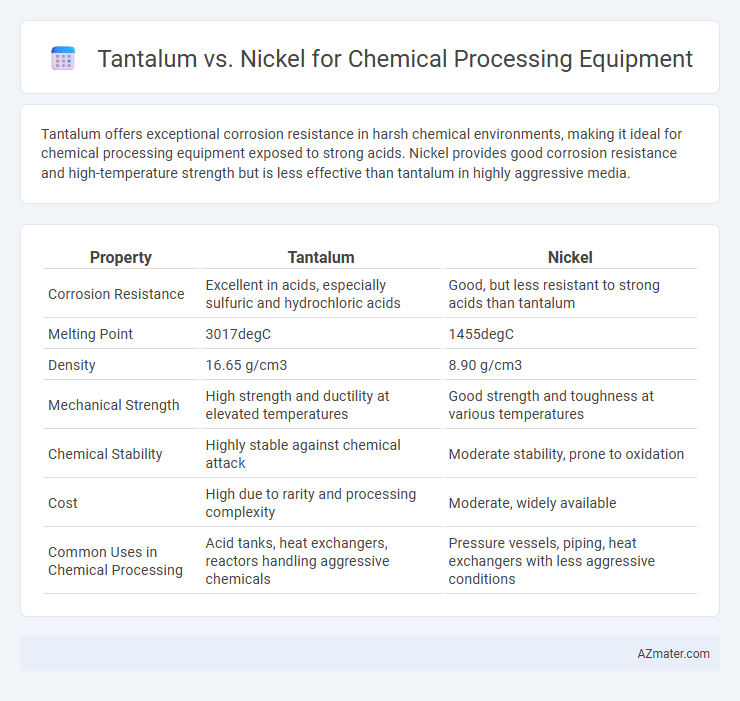Tantalum offers exceptional corrosion resistance in harsh chemical environments, making it ideal for chemical processing equipment exposed to strong acids. Nickel provides good corrosion resistance and high-temperature strength but is less effective than tantalum in highly aggressive media.
Table of Comparison
| Property | Tantalum | Nickel |
|---|---|---|
| Corrosion Resistance | Excellent in acids, especially sulfuric and hydrochloric acids | Good, but less resistant to strong acids than tantalum |
| Melting Point | 3017degC | 1455degC |
| Density | 16.65 g/cm3 | 8.90 g/cm3 |
| Mechanical Strength | High strength and ductility at elevated temperatures | Good strength and toughness at various temperatures |
| Chemical Stability | Highly stable against chemical attack | Moderate stability, prone to oxidation |
| Cost | High due to rarity and processing complexity | Moderate, widely available |
| Common Uses in Chemical Processing | Acid tanks, heat exchangers, reactors handling aggressive chemicals | Pressure vessels, piping, heat exchangers with less aggressive conditions |
Introduction to Tantalum and Nickel in Chemical Processing
Tantalum and nickel are critical materials used in chemical processing equipment due to their exceptional corrosion resistance and mechanical properties. Tantalum excels in highly aggressive environments involving strong acids like sulfuric and hydrochloric acid, offering superior durability and resistance to pitting and crevice corrosion. Nickel, often alloyed in forms such as Inconel and Hastelloy, provides robust performance in both oxidizing and reducing environments, making it a versatile choice for reactors, heat exchangers, and piping systems in chemical plants.
Material Properties: Tantalum vs Nickel
Tantalum exhibits superior corrosion resistance in highly acidic environments, particularly against hydrochloric and sulfuric acids, making it ideal for chemical processing equipment exposed to aggressive chemicals. Nickel offers excellent mechanical strength and robustness, along with moderate corrosion resistance in alkaline and oxidizing conditions, suitable for diverse industrial applications. The density of tantalum (16.6 g/cm3) is higher than nickel (8.9 g/cm3), impacting design considerations where weight and durability are critical factors.
Corrosion Resistance Comparison
Tantalum exhibits superior corrosion resistance compared to nickel in highly aggressive chemical environments, particularly against strong acids like hydrofluoric acid, sulfuric acid, and hydrochloric acid. Nickel alloys, while resistant to many chemicals, can suffer from pitting and stress corrosion cracking in chloride-rich conditions where tantalum remains stable. This makes tantalum the preferred choice for chemical processing equipment requiring maximum durability and longevity under extreme corrosive conditions.
Mechanical Strength and Durability
Tantalum exhibits superior corrosion resistance and excellent ductility, making it ideal for chemical processing equipment subjected to aggressive media, while nickel provides higher mechanical strength and toughness at elevated temperatures. Tantalum's durability in acidic environments, especially against hydrochloric and sulfuric acids, ensures long service life with minimal degradation, whereas nickel alloys offer enhanced wear resistance and strength under thermal and mechanical stress. Selecting between tantalum and nickel depends on specific process conditions, balancing chemical inertness and mechanical robustness for optimal equipment performance.
Temperature and Pressure Limits
Tantalum exhibits superior corrosion resistance and maintains structural integrity at temperatures up to 1500degC, making it ideal for high-temperature chemical processing environments. Nickel alloys commonly operate effectively at temperatures up to 1000degC, offering strong mechanical properties under moderate pressure conditions. Tantalum's high melting point and excellent resistance to chemical attack enable it to withstand extreme pressure and temperature, outperforming nickel in highly aggressive processing applications.
Cost Analysis: Tantalum vs Nickel
Tantalum offers superior corrosion resistance in harsh chemical environments but comes with a significantly higher upfront cost compared to nickel, which is more cost-effective for moderate conditions. Nickel provides a balance between durability and affordability, making it a preferred choice for large-scale chemical processing equipment where budget constraints are critical. Long-term maintenance expenses often favor tantalum in highly aggressive media due to its extended lifespan and reduced downtime, offsetting initial cost differences.
Applications in Chemical Processing Equipment
Tantalum is highly preferred in chemical processing equipment due to its exceptional corrosion resistance against aggressive acids such as hydrofluoric and sulfuric acids, making it ideal for reactor vessels, heat exchangers, and piping systems in pharmaceuticals and semiconductor industries. Nickel offers robust resistance to alkaline environments and moderate corrosion, widely used in chemical reactors, valves, and storage tanks for applications involving caustic solutions and oxidative conditions. The selection between tantalum and nickel hinges on specific chemical compatibility requirements, operating temperatures, and cost considerations in complex chemical processing environments.
Fabrication and Maintenance Considerations
Tantalum offers superior corrosion resistance and excellent weldability, making it ideal for chemical processing equipment but requires specialized fabrication techniques due to its high melting point and softness. Nickel, while easier to fabricate with conventional methods and more cost-effective, may require additional maintenance like passivation to maintain corrosion resistance in aggressive chemical environments. Maintenance of tantalum equipment tends to be lower due to its inert surface, whereas nickel components might need periodic inspection and surface treatment to prevent degradation.
Environmental and Safety Impacts
Tantalum offers superior corrosion resistance and biocompatibility, minimizing environmental contamination risks in chemical processing equipment compared to nickel, which is prone to nickel ion release causing potential environmental toxicity. Tantalum's non-toxic nature and inertness reduce occupational health hazards, whereas nickel exposure can lead to allergic reactions and respiratory issues among workers. The recyclability and long lifecycle of tantalum contribute to lower environmental impact and improved sustainability over nickel in industrial applications.
Choosing the Right Material for Your Process
Tantalum offers exceptional corrosion resistance against strong acids such as sulfuric and hydrochloric acid, making it ideal for highly aggressive chemical processing environments, whereas nickel excels in resistance to caustic media and oxidizing agents, often used in alkaline and moderately acidic applications. Material selection depends on process temperature, chemical composition, and cost considerations, with tantalum preferred for extreme corrosive conditions despite higher costs, while nickel provides a cost-effective solution for less aggressive but still demanding conditions. Evaluating factors such as alloy grade, mechanical properties, and long-term stability ensures optimal performance and equipment longevity in chemical processing operations.

Infographic: Tantalum vs Nickel for Chemical processing equipment
 azmater.com
azmater.com